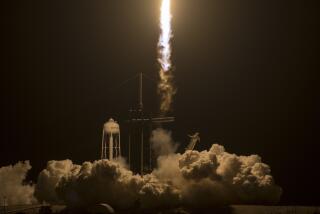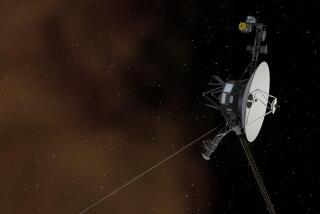Single Cause Suspected for Many Woes of Magellan : Space: Scientists think they can work around the problem. They hope to start mapping Venus by the end of the month.
- Share via
Scientists at the Jet Propulsion Laboratory who are trying to nurse the Magellan spacecraft back to good health believe both of the failures that hit the Venus orbiter last month may have resulted from a single cause rather than multiple problems.
Furthermore, it may not be necessary to fully understand the cause of the twin communications blackouts in order to work around the problem, said JPL scientist Stephen Wall.
“That’s the best news yet,” Wall said in a briefing televised to space centers around the country.
Since its last blackout on Aug. 21, Magellan had been operating on a small backup computer to lessen the chance of engineers losing control of the craft as it orbits Venus 153 million miles from Earth. On Saturday, the craft’s main computer was switched on and has worked well since.
“We carefully watched the spacecraft for eight hours,” Wall said. “Everything went fine.”
Scientists are studying data from that eight-hour period with the expectation that it will help them narrow the problem down to the “root cause,” Wall added.
That progress has encouraged scientists to put the craft through a series of maneuvers next week, and they hope to begin mapping the surface of Venus by the end of the month. On Tuesday, they will switch to a “medium gain antenna” used to transmit commands to the craft at a higher rate than is now possible. Wednesday they will try out the “high gain antenna,” which will be used to transmit huge amounts of data from the craft to Earth.
Thursday, they will examine the results, plus data sent back before the problems occurred, “to see if it will tell us anything more about what happened during the first anomaly,” Wall said.
Meanwhile, scientists continued to study the single strip of images that Magellan transmitted back to Earth before the problems began. The images are about 10 times sharper than photos from previous spacecraft, and they are giving scientists a tantalizing preview of what to expect during the two years that Magellan is to photograph nearly the entire surface of Earth’s sister planet. The craft uses a radar camera that penetrates through the dense layer of Venusian clouds.
So far, everything seen by the scientists supports long-held theories that the surface of Venus has been very active in the recent geological past.
“We see a lot of areas in which the surface is deformed, pulled apart or pushed together,” much like the tectonic processes on Earth, said Jim Head of Brown University, a member of the Magellan science team.
Some of the features appear to be quite young, geologically speaking, Head said. They seem to have been created by processes that have occurred within the last few tens of millions to hundreds of millions of years, “and maybe even today.”






